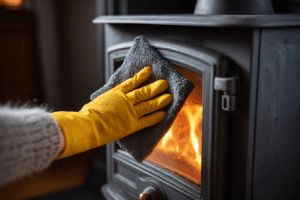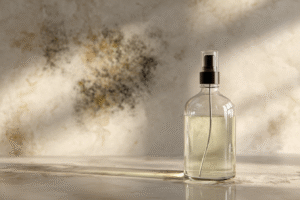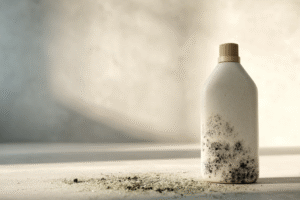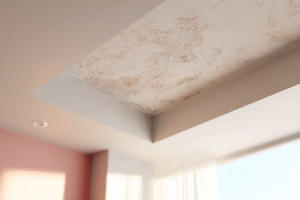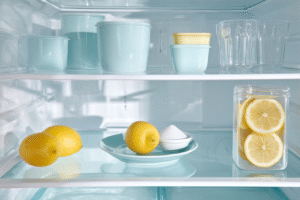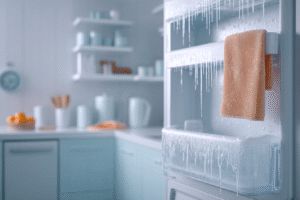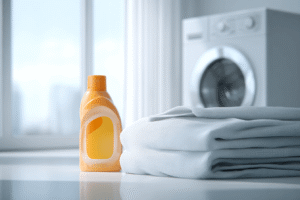Summarise this article with:
Spotted some uninvited guests on your ceiling? Those dark, unsightly patches aren’t just an eyesore—they’re mold, and they’ve got to go! Don’t worry though, we’ve got your back. Mold on the ceiling is more common than you’d think, especially in British homes where humidity loves to make itself at home. In this guide, we’ll walk you through the main causes of ceiling mould, how to safely get rid of it, and the best ways to stop it from coming back. Ready to roll up your sleeves? Let’s dive in!

What Causes Black Mould on Ceilings?
Before we start trying to get rid of those stubborn black mould on your ceiling, let’s understand why it’s gatecrashed your ceiling in the first place.
High humidity is the main villain here. When warm, humid air meets your cold ceiling, condensation forms—creating the perfect mould paradise. It’s the same reason you often see mould on windows, where condensation gathers most.
Poor ventilation makes things worse by trapping that humid air with nowhere to escape. Bathrooms and bedrooms are prime targets thanks to steamy showers and overnight breathing.
Leaks and water damage from dodgy roofs or plumbing give mould the green light to move in. Any excess moisture plus contact with cold surfaces equals trouble.
Essential Tools and Safety Gear
Before you start your mold-busting mission, let’s get you properly kitted out. Safety first, as they say!
Protective Equipment:
- N-95 mask or respirator (non-negotiable!)
- Rubber gloves (long ones are best)
- Safety goggles or eye protection
- Old clothes you don’t mind getting messy
Cleaning Supplies:
- White vinegar
- Bleach (for stubborn cases)
- Baking soda
- Clean water
- Spray bottles
- Wet sponges and scrub brushes
- Clean cloths for wiping
- Plastic sheeting (for containment)
Equipment:
- Sturdy ladder or step stool
- Bucket for mixing solutions
- Tablespoon for measuring baking soda
Got everything? Brilliant! Now we’re ready to show that mold who’s boss.
Step-by-Step Methods to Remove Mould from Ceiling
Method 1: How to Remove Mould from Ceiling with Vinegar
Vinegar is your eco-friendly superhero in the fight against mold. It’s natural, effective, and won’t harm your home or family.
- Prepare your solution: Pour undiluted white vinegar into a spray bottle. No mixing needed—pure white vinegar works best for mould.
- Spray the affected area: Liberally spray the moldy ceiling areas. Don’t be shy—give it a proper coating.
- Let it sit: Allow the vinegar to work its magic for at least one hour. This gives it time to penetrate and kill the mold.
- Scrub gently: Using a wet sponge or soft brush, gently scrub the area. The mold should come away easily.
- Rinse and dry: Wipe the area with a clean, damp cloth, then dry thoroughly with a towel.
- Prevention spray: For extra protection, spray the area again with vinegar and let it air dry. This helps prevent future growth.
Top tip: Open windows and ensure good ventilation throughout the process. The vinegar smell will dissipate, leaving your ceiling mold-free!
Method 2: How to Kill Mould on Ceiling Using a Bleach Solution
Safety first: Ensure excellent ventilation, wear all protective gear, and never mix bleach with other cleaning products.
When it comes to killing mould with bleach, start by:
- Mixing your solution: Combine one part bleach with three parts water in a spray bottle. This ratio is effective yet safe for most ceiling surfaces.
- Test first: Try the solution on a small, inconspicuous area to ensure it won’t damage your ceiling paint.
- Apply carefully: Spray the bleach solution onto the moldy areas. Work in sections to maintain control.
- Wait and watch: Let the solution sit for 10-15 minutes. You should see the mold beginning to lighten.
- Scrub away: Using a scrub brush, gently work the solution into the mold. Don’t scrub too hard—you don’t want to damage the ceiling.
- Rinse thoroughly: This step is crucial. Use clean water to remove all bleach residue, then dry the area completely.
Remember: Never leave bleach solution on your ceiling. Always rinse thoroughly to prevent damage to your ceiling paint.
Method 3: Baking Soda Solution
- Create your paste: Mix one tablespoon of baking soda with enough water to form a thick paste.
- Apply generously: Spread the paste over the moldy areas using a sponge or cloth.
- Let it work: Allow the paste to sit for 10-15 minutes.
- Scrub gently: Use a wet sponge to scrub the area in circular motions.
- Rinse and repeat: Rinse with clean water, then spray the area with a baking soda and water solution (1 tablespoon per cup of water) for ongoing protection.
This method is brilliant for regular maintenance and prevention, though it might need repeating for stubborn mold.
Method 4: Specialist Mould Removal Sprays
Sometimes, you need purpose-built tools for the job. Commercial mold removal sprays can be incredibly effective, especially for persistent problems.
Application tips:
- Follow manufacturer instructions to the letter
- Ensure excellent ventilation
- Test on a small area first
- Don’t over-apply—more isn’t always better
- Allow proper drying time
These sprays often contain fungicides specifically designed to kill mold and prevent regrowth. They’re particularly useful for bathroom ceilings where humidity is consistently high.
How to Remove Mould from Different Ceiling Types
Remove Mould from Bathroom Ceiling
Bathroom ceilings face unique challenges. The constant cycle of hot showers and steam creates the perfect mold habitat.
To remove mold from bathroom ceiling, start by:
- Use vinegar or bleach
- Always ventilate during and after cleaning
- Consider applying anti-mould paint afterwards
Extra precautions:
- Always run the extractor fan during and after showers
- Open windows when possible to improve air circulation
- Clean regularly with antifungal solutions
The vinegar method works particularly well in bathrooms, as it’s safe around water and won’t damage typical bathroom fixtures.
How to Remove Mould from Painted Ceiling
Painted ceilings require a gentle touch to preserve the finish. Test any cleaning solution in an inconspicuous spot first.
Protecting ceiling paint:
- Use the mildest effective method first
- Avoid harsh scrubbing that might damage the paint
- Consider touching up paint after cleaning
- If mold has penetrated the paint, you might need to repaint entirely
Sometimes, the most effective way forward is cleaning followed by a fresh coat of anti-mould paint.
Mould on Ceiling Tiles
Ceiling tiles present their own challenges due to their porous nature and textured surfaces.
Special considerations:
- Mold can penetrate deeply into porous tiles
- Replacement might be more cost-effective than cleaning
- If cleaning, use minimal water to avoid damage
- Professional assessment might be worthwhile for extensive problems
For minor surface mold, gentle brushing with a dry brush followed by vacuuming can be effective.
Effective Ways to Prevent Mould from Returning
Cleaning mold is only half the battle. Prevention is where the real magic happens!
Better Ventilation Solutions
Install extractor fans: Particularly crucial in bathrooms and kitchens. They remove humid air before it can cause problems.
Open windows regularly: Fresh air circulation is your best friend. Even a few minutes daily can make a significant difference.
Improve air circulation: Use ceiling fans or portable fans to keep air moving throughout your home.
Humidity Control
Manage humid air: Keep indoor humidity below 60%. Use dehumidifiers in problem areas if necessary.
Monitor moisture levels: Invest in a humidity meter to keep track of conditions in different rooms.
Address sources: Fix leaks promptly and ensure proper insulation to prevent condensation.
Long-term Prevention
Regular maintenance: Clean your ceiling monthly with a mild vinegar solution to prevent mold establishment.
Anti-mould paint: Consider specialty paints designed to resist mold growth, especially in high-humidity areas.
Address underlying issues: Fix ventilation problems, improve insulation, and ensure your home can “breathe” properly.
When to Call Professional Mould Removal Services
Sometimes, DIY methods aren’t enough. Here’s when it’s time to call in the cavalry:
- Mold covers more than 10 square feet
- You have health conditions that make exposure risky
- The mold keeps coming back despite your best efforts
- You suspect hidden mold behind walls or above ceilings
- The affected area shows signs of structural damage
Professional services have specialised equipment, protective gear, and expertise to handle extensive mold problems safely. They can also identify and address underlying moisture sources that might not be obvious.
Frequently Asked Questions
How do you get rid of mold in a bathroom?Focus on ventilation and regular cleaning. Use exhaust fans, open windows, and clean weekly with vinegar solution. Address any leaks immediately.
How do you remove black mould from a ceiling?Start with vinegar for safety. If that doesn’t work, try a bleach solution with proper ventilation and safety gear. For extensive black mould, consider professional help.
What’s the most effective way to treat mould on a ceiling?Prevention through proper ventilation and humidity control. For existing mold, vinegar is safest for regular cleaning, while bleach solution handles stubborn cases.
How do you get rid of mould on ceiling above a shower?Improve bathroom ventilation first, then clean with vinegar or specialist bathroom mold removers. Consider anti-mould paint for long-term protection.
Can I remove mould myself or should I hire professionals?Small areas (under 10 square feet) can usually be handled with proper safety precautions. Larger areas, persistent problems, or health concerns warrant professional intervention.
Mould on the ceiling is more than just a cosmetic issue—it can affect your health and home. The good news? With the right tools and a little elbow grease, you can tackle most mould problems yourself. From vinegar to specialist sprays, this guide has covered the best methods to get rid of ceiling mould safely and effectively. But don’t forget—the key to keeping it away is fixing the root cause: moisture.



